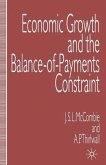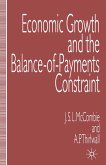- Broschiertes Buch
- Merkliste
- Auf die Merkliste
- Bewerten Bewerten
- Teilen
- Produkt teilen
- Produkterinnerung
- Produkterinnerung
Contains a statement of balance-of-payments accounting, and a critical appraisal of balance-of-payments adjustment theory. The book also features chapters on the capital account of balance-of-payments and the theory of exchange rate determination in the United Kingdom.
Andere Kunden interessierten sich auch für
![Balance-Of-Payments Theory and the United Kingdom Experience Balance-Of-Payments Theory and the United Kingdom Experience]() Heather D. GibsonBalance-Of-Payments Theory and the United Kingdom Experience112,99 €
Heather D. GibsonBalance-Of-Payments Theory and the United Kingdom Experience112,99 €![Economic Growth and the Balance-Of-Payments Constraint Economic Growth and the Balance-Of-Payments Constraint]() John McCombieEconomic Growth and the Balance-Of-Payments Constraint149,99 €
John McCombieEconomic Growth and the Balance-Of-Payments Constraint149,99 €![Economic Growth and the Balance-Of-Payments Constraint Economic Growth and the Balance-Of-Payments Constraint]() John McCombieEconomic Growth and the Balance-Of-Payments Constraint210,99 €
John McCombieEconomic Growth and the Balance-Of-Payments Constraint210,99 €![Models of Balance of Payments Constrained Growth Models of Balance of Payments Constrained Growth]() Models of Balance of Payments Constrained Growth75,99 €
Models of Balance of Payments Constrained Growth75,99 €![EU Payments Integration EU Payments Integration]() Ruth WandhöferEU Payments Integration75,99 €
Ruth WandhöferEU Payments Integration75,99 €![EU Payments Integration EU Payments Integration]() Ruth WandhöferEU Payments Integration75,99 €
Ruth WandhöferEU Payments Integration75,99 €![The Growth of Public Expenditure in the United Kingdom from 1870 to 2005 The Growth of Public Expenditure in the United Kingdom from 1870 to 2005]() Clive LeeThe Growth of Public Expenditure in the United Kingdom from 1870 to 200575,99 €
Clive LeeThe Growth of Public Expenditure in the United Kingdom from 1870 to 200575,99 €-
-
-
Contains a statement of balance-of-payments accounting, and a critical appraisal of balance-of-payments adjustment theory. The book also features chapters on the capital account of balance-of-payments and the theory of exchange rate determination in the United Kingdom.
Produktdetails
- Produktdetails
- Verlag: Palgrave Macmillan / Palgrave Macmillan UK / Springer Palgrave Macmillan
- Artikelnr. des Verlages: 978-0-333-56648-0
- 4. Aufl.
- Seitenzahl: 452
- Erscheinungstermin: 2. Dezember 1991
- Englisch
- Abmessung: 216mm x 140mm x 25mm
- Gewicht: 571g
- ISBN-13: 9780333566480
- ISBN-10: 0333566483
- Artikelnr.: 26380118
- Herstellerkennzeichnung Die Herstellerinformationen sind derzeit nicht verfügbar.
- Verlag: Palgrave Macmillan / Palgrave Macmillan UK / Springer Palgrave Macmillan
- Artikelnr. des Verlages: 978-0-333-56648-0
- 4. Aufl.
- Seitenzahl: 452
- Erscheinungstermin: 2. Dezember 1991
- Englisch
- Abmessung: 216mm x 140mm x 25mm
- Gewicht: 571g
- ISBN-13: 9780333566480
- ISBN-10: 0333566483
- Artikelnr.: 26380118
- Herstellerkennzeichnung Die Herstellerinformationen sind derzeit nicht verfügbar.
Author A.P. Thirlwall: Tony has lectured widely in developing countries and has been a consultant to several international agencies including the African Development Bank, the Asian Development Bank, the UN Conference on Trade and Development (UNCTAD) and the Pacific Islands Development Program in Hawaii. He has written a number of specialized texts in the field of development economics and is Series Editor of Palgrave's Great Thinkers in Economics collection.
Part 1 Balance-of-payments accounting and the foreign-exchange market: concepts of the balance of payments; the accounting balance of payments; balance-of-payments equilibrium; more on the concept of equilibrium; the foreign-exchange market; the demand for dollars; the supply of dollars; capital movements and speculation; the forward rate of exchange; types of exchange-rate regime; fixed versus flexible exchange rates; exchange rate reform. Part 2 The capital account of the balance of payments: the components of the capital account; official reserves; special drawing rights; the balancing item; the capital account and the net external wealth of the UK. Part 3 Exchange rate determination: theories of exchange rate determination; purchasing power parity; current balance model; the importance of theories of expectations formation; the Mundell-Fleming model; exchange rate overshooting models; the portfolio model of exchange rate determination; speculatice bubble models of exchange rate determination; exchange rate determination - what have we learnt?; exchange rate systems and policies; fixed versus flexible exchange rates; types of exchange rate regime; controls on capital movements; exchange rate policy in the 1990s. Part 4 The balance of payments and the national economy: the integration of the balance of payments into the nationnal accounts; the conflict between balance-of-payments equilibrium and other objectives of economic policy; income equilibrium in an open economy and the foreign-trade mulitplier; the foreign-trade multiplier relating imports to expenditure; the 'new' foreign-trade multiplier with foreign repercussions; balance-of-payments adjustment; the classical price-specie flow mechanism; the elasticity approach; the absorption approach; the monetary approach. Part 5 The elasticity approach to the balance of payments: the Marshall-Lerner condition derived; devaluation and the response of firms; lags and the J-curve effect; devaluation and inflation; payments imbalance in the World economy; devaluation and the terms of trade; the difficulties of measuring price elasticities. Part 6 The absorption approach to the balance of payments: the direct effect of devaluation on income; the direct effect of devaluation on absorption; the interaction between changes in income and changes in absorption; strengths and dangers of the absorption approach; the monetary aspects of balance-of-payments deficits; domestic credit expansion. Part 7 The monetary approach to the balance of payments. Part 8 Simultaneous internal and external balance: internal and external balance under flexible exchange rates with no capital movements; internal and external balance under fixed exchange rate woth capital movementsl internal and external balance in an IS-LM curve framework; the use of monetary and fiscal policy under alternative exchange-rate regimes; the assignment of policies in the United Kingdom. (part contents).
Part 1 Balance-of-payments accounting and the foreign-exchange market: concepts of the balance of payments; the accounting balance of payments; balance-of-payments equilibrium; more on the concept of equilibrium; the foreign-exchange market; the demand for dollars; the supply of dollars; capital movements and speculation; the forward rate of exchange; types of exchange-rate regime; fixed versus flexible exchange rates; exchange rate reform. Part 2 The capital account of the balance of payments: the components of the capital account; official reserves; special drawing rights; the balancing item; the capital account and the net external wealth of the UK. Part 3 Exchange rate determination: theories of exchange rate determination; purchasing power parity; current balance model; the importance of theories of expectations formation; the Mundell-Fleming model; exchange rate overshooting models; the portfolio model of exchange rate determination; speculatice bubble models of exchange rate determination; exchange rate determination - what have we learnt?; exchange rate systems and policies; fixed versus flexible exchange rates; types of exchange rate regime; controls on capital movements; exchange rate policy in the 1990s. Part 4 The balance of payments and the national economy: the integration of the balance of payments into the nationnal accounts; the conflict between balance-of-payments equilibrium and other objectives of economic policy; income equilibrium in an open economy and the foreign-trade mulitplier; the foreign-trade multiplier relating imports to expenditure; the 'new' foreign-trade multiplier with foreign repercussions; balance-of-payments adjustment; the classical price-specie flow mechanism; the elasticity approach; the absorption approach; the monetary approach. Part 5 The elasticity approach to the balance of payments: the Marshall-Lerner condition derived; devaluation and the response of firms; lags and the J-curve effect; devaluation and inflation; payments imbalance in the World economy; devaluation and the terms of trade; the difficulties of measuring price elasticities. Part 6 The absorption approach to the balance of payments: the direct effect of devaluation on income; the direct effect of devaluation on absorption; the interaction between changes in income and changes in absorption; strengths and dangers of the absorption approach; the monetary aspects of balance-of-payments deficits; domestic credit expansion. Part 7 The monetary approach to the balance of payments. Part 8 Simultaneous internal and external balance: internal and external balance under flexible exchange rates with no capital movements; internal and external balance under fixed exchange rate woth capital movementsl internal and external balance in an IS-LM curve framework; the use of monetary and fiscal policy under alternative exchange-rate regimes; the assignment of policies in the United Kingdom. (part contents).








